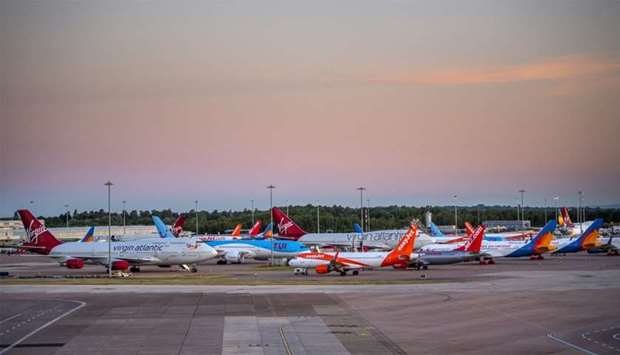Financially, 2020 will go down as the “worst” year in the history of commercial aviation as it faces the gravest peacetime crisis following the Covid-19 outbreak.
Airlines are set to lose $84bn in 2020 as coronavirus killed their revenue by half already, marking the worst year in the sector’s history.
That is steeper than initially forecast and comes amid recent signs that travellers are returning to the skies.
Covid-19 lockdowns have led to an almost complete standstill in airline travel worldwide. Many airlines have grounded most of their flights, globally.
Obviously, grounded planes do not make money. In fact, storing and maintaining them comes at a hefty price tag!
Since the pandemic, airlines have been counting the cost of weeks of lost business, a debt pile swollen by bailouts and a diminished demand outlook.
A sharp fall in demand and revenue has forced many airlines to slash costs, and in several countries, governments are stepping in to infuse funds and keep their national airlines or flagbearers afloat.
And even in markets where Covid-19 infection rates have fallen sharply, airlines still face a patchwork of travel restrictions and wary consumers.
Collectively, airlines are expected to lose $84.3bn in 2020, according to the International Air Transport Association. Total revenues will fall 50% to $419bn.
In 2021, losses will reduce to $15.8bn as revenues rise to $598bn.
“On average, every day of this year will add $230mn to industry losses. It means that—based on an estimate of 2.2bn passengers for 2020—airlines will lose $37.54 per passenger. That’s why government financial relief was and remains crucial as airlines burn through cash,” points out IATA director general and CEO Alexandre de Juniac.
Airlines will still be financially fragile in 2021,” he said, predicting “even more intense” competition ahead.
“That will translate into strong incentives for travellers to take to the skies again,” de Juniac added.
The main driver of the losses is the evaporation of passenger demand as international borders closed, and countries locked down. At the low point in April, global air travel was roughly 95% below 2019 levels.
But there are indications that traffic is slowly improving. Nonetheless, traffic levels (in revenue passenger kilometers) for 2020 are expected to fall 54.7% compared with 2019.
Passenger numbers of 2.2bn is approximately equal to 2006 levels, IATA says. Capacity, however, cannot be adjusted quickly enough with a 40.4% decline expected for the year.
Passenger yields will therefore fall an expected 18% as airlines try to encourage people to fly again through price stimulation. Load factors are expected to average 62.7% for 2020, some 20 percentage points below the record high of 82.5% achieved in 2019.
Unfortunately, costs are not falling as fast as demand. Though expenses of $517bn are 34.9% below 2019 levels, revenues will see a 50% drop.
Non-fuel unit costs will rise 14.1%, as fixed costs are spread over fewer passengers. Lower utilisation of aircraft and seats because of restrictions will also add to rising costs.
Fuel prices offer some relief though. In 2019, jet fuel averaged $77 per barrel whereas the forecast average for 2020 is $36.8/b. Fuel is expected to account for 15% of overall costs (compared with 23.7% in 2019).
While the near-term travel outlook remains uncertain, the nearly 50% year-on-year fall in fuel price provides some silver lining to the global airline industry.
Cargo, a relatively small share of the overall business, also brought some relief as mass plane groundings drove price increases expected to top 30%, IATA said, helping revenue to a near-record $111bn.
Cargo volumes will drop 10.3mn tonnes to 51mn tonnes. However, a severe shortage in cargo capacity due to the unavailability of belly cargo on (grounded) passenger aircraft is expected to push rates up some 30% for the year.
The value air cargo brings to the world has never been more apparent. Many airlines have been involved in humanitarian flights during the Covid-19 pandemic and together with their partners in the logistics chain ensured personal protective equipment (PPE) and other urgent medical supplies reached their destination.
“Without air cargo, there is no doubt that the impact of the global coronavirus outbreak would have been far worse,” points out Glyn Hughes, IATA’s head (Cargo).
While there are signs travel is starting to pick up, the recovery has been slow, complicated by economic downturn and government quarantines.
In the US, the Transportation Security Administration screened more than 440,000 people at airport checkpoints on June 7. That's up from fewer than 100,000 people in April, but still down more than 80% from last year.
Early this year, the aviation industry was worrying about the disruption to traffic in China, a key market, because of the coronavirus. Today, the industry is grounded - globally, a sign of just how quickly the Covid-19 pandemic has developed.
For the airline industry, it means a plunge in travel demand and idling capacity, loss of huge revenue and millions of jobs worldwide.
Simply put, airlines are now struggling to stay afloat!
*Pratap John is Business Editor at Gulf Times. Twitter handle: @PratapJohn




